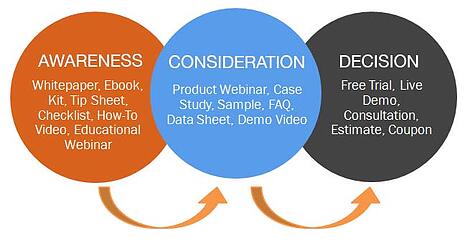 You’re in the business of generating new website leads and customers, not just website visitors, right? To get the leads you want, you have to ask visitors to move forward—to begin a relationship with your organization. To achieve this, a call to action (CTA) is the most effective tool you have in your arsenal, since it will get your visitors to act right now.
You’re in the business of generating new website leads and customers, not just website visitors, right? To get the leads you want, you have to ask visitors to move forward—to begin a relationship with your organization. To achieve this, a call to action (CTA) is the most effective tool you have in your arsenal, since it will get your visitors to act right now.
What Is a Call-to-Action?
A call-to-action is a button that directs visitors to what they should do next as they browse your website. CTA buttons take visitors to pages where they can download eBooks, guides, comparisons, and so on. These pages, also known as landing pages, usually have a form that prompts the visitors to provide their information in exchange for the information they’d like to download. Once a visitor completes the form, you’ve got yourself a lead!
It all starts with the CTA button.
The design of the button itself is quite important. It has to stand out on the page, and it must inform the visitor of what will happen next. The traditional grayscale “Submit” button isn’t going to cut it anymore. You need a large, colorful button with a more specific message, such as “Download Your eBook” or “Sign Up.”
How the CTA Button Works
A customer that knows your company well will be happy to buy from you. But it takes a longer time to build that level of familiarity and trust with someone who is just starting to know you. Therefore, your CTAs need to provide actions for all stages of the buyer’s journey through the sales funnel.
Next, we’ll describe the three main phases of the sales funnel. We’ll explain how a CTA can help you move your visitors through the sales funnel, transforming them to leads along the way.

Phase 1. Awareness
Visitors to your website are in the awareness phase of the sales funnel when they’re just starting to learn about you. The information you present helps them become familiar with your company and its products or services. As visitors browse your site, they should encounter CTA buttons with eBooks, guides and educational materials that provide more information not on your solution, but on their need.
Phase 2. Consideration
The consideration phase is when prospects are narrowing down their searches to the few companies they’d like to explore further. During this phase, they are likely to be doing in-depth research, making comparisons, and visiting review sites to make the best possible choices. At this stage, your CTA buttons can offer them case studies and comparison charts. Describe how your company can help solve their needs, closing the gap between the educational assets and product/service information.
Phase 3. Decision
In the decision phase, your prospect is ready to make a decision. They're now more educated about their problem and understand why your company is a good choice for solving it. Your CTA buttons for this stage could include free trials, live demos, consultations and estimates.
In summary, a call to action is necessary to convert visitors into leads. It’s a great way to inform and demonstrate the value you can provide. It’s your job to make sure your prospects have the information they need to make the right choices. But remember, CTAs are just the beginning. Not all leads will be ready to buy, so you must have a lead-nurturing campaign to continue to move prospects through the sales funnel.
At Xzito, we work with clients to understand their buyers’ journeys through the sales funnel, and we develop effective CTAs to increase web conversion. Schedule a free one-on-one consultation to find out more about how CTAs can help you improve your return on investment.










